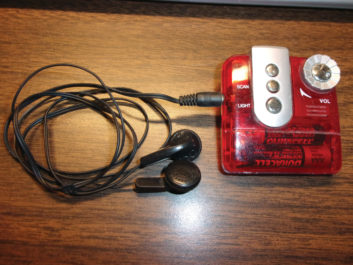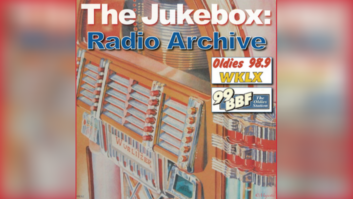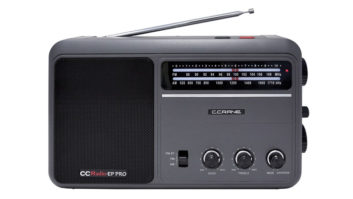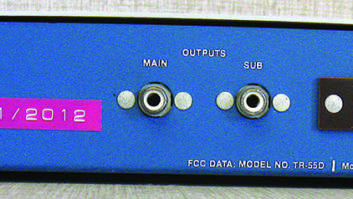This article was originally published in the Jan. 20, 2016 issue of Radio World Engineering Extra.
“Milestones” is a series of reminiscences about notable radio technological developments.
Some of us remember when the Federal Communications Commission would choose standards based on consensus and technical performance evaluations rather than marketplace choices. FM stereo was among the products of this period.

The quest for a workable broadcast system to deliver high-fidelity stereo began in the late 1940s and received impetus when serious audiophiles began buying stereo reel-to-reel tapes of live recordings in a big way around 1955. Tape listeners enjoyed the aural presence and spatial relationship of performances in a variety of formats: classical, jazz and big band music. If the playback device reproduced without color and could generate comparable audio levels, you almost felt that you were there.
The tape medium was awkward for consumers, though, and several stereo record systems appeared in response. The RIAA finally settled on the CBS micro-grooved, long-play record format, and stereo sound appeared industry-wide in late 1957, reaching consumers in early 1958.
Stereo audio settled into the consciousness of America. The original CinemaScope wide-screen theatre display system inculcated stereo sound on high-fidelity magnetic tape tracks on the edge of 35 mm film. In broadcast, NBC tried to generate interest in TV stereo with a 1958 demonstration during “The George Gobel Show” that was carried in color; the next February, “The Perry Como Show” demoed stereo featuring a bouncing ball that was supposed to go from left to right and back; the second audio channel was provided by cooperating NBC network radio affiliates. Unfortunately, the effect suffered from poor audio isolation and aggressive level changes of the modulation control packages at these stations.
Ad Hoc Standard
A friend of mine in the computer world used to joke that the great thing about standards is that there are so many from which to choose.
Although the United States has only one stereo FM broadcasting technology today, there was an earlier half-step, ad hoc standard.
With the emergence of FM broadcasting, many AM stations added an FM signal, if for no other reason than to save a place in broadcasting’s future. The question of what to do with these new FMs arose quickly.
A sort of marketplace “AM-FM stereo” system standard for binaural broadcasting appeared, with one channel on the AM (left) and the other on the FM (right). These were the days before NRSC audio frequency reduction, so the audio response on AM was notably better. Vendors offered better receivers to the connoisseur; and the reception environment was far friendlier than today, with less electrification, less band noise and fewer stations. AMs could sound pretty good; all FM signals were hi-fi mono.
Several receiver manufacturers sold units capable of receiving the AM-FM stereo system. Consoles were the most popular version; the selector switch inside had settings for AM or FM and AM-FM stereo.
Although I cannot identify any stations that were full-time dual stereo, AM-FM station pairs that cleared limited air time for AM-FM stereo broadcast included WFIL and WFLN in Philadelphia, WABC in New York, WPEL in Montrose, Pa., and WTIC in Hartford, among others. For example, WBZ Boston would break format on Sundays at 7 p.m. for the “Stereo Hour,” during which one program would be broadcast in AM-FM stereo.
The Achilles Heel of this scheme was that when you listened to just one or the other of the paired stations, your ears heard only half of the program information. Another drawback was economic; a station would lose half of its spot positions.
The challenge for the radio industry of the late 1950s was to combine FM’s superior audio quality with stereo’s heightened sense of realism to provide true high-fidelity spatial sound to listeners.

True Hi-Fi Spatial Sound
The solution was to encode both channels in a single FM signal using multiplex techniques.
In the late 1950s, the FCC considered a multitude of systems to add stereo to FM radio. Fourteen proponents put forward systems including industry heavyweights such as Crosley, Halstead, EMI, Zenith and General Electric. Of these, eight were deemed to provide desirable qualities and acceptable performance. Six got as far as detailed field-testing. A technical industry committee formed, and the surviving systems were evaluated for their performance qualities during field tests in Uniontown, Pa., using KDKA(FM) in Pittsburgh as the transmitter test bed. The GE and Zenith systems were so similar that they were considered theoretically identical.
The final report and order came down to two real contenders. A unified GE-Zenith scheme bearing the fusion moniker of system 4-4A was deemed superior and formally approved by the FCC in April 1961 as the standard stereo FM broadcasting method in the United States, and subsequently by most of the worldwide radio industry.
The FCC authorized regular stereo FM to start June 1, 1961. WGFM (now WRVE, Schenectady, N.Y.) was the first station to go stereo at midnight Eastern time. WEFM Chicago, had to wait an hour later until midnight in the Windy City, as the implementation order specified local time, making them second to go on-air.
WGFM was owned by General Electric and not far from its broadcast equipment division labs in Syracuse; it was a co-proponent of the multiplex standard, so it was hardware-ready to go to stereo.
The national experience with color TV had taught the industry that any FM stereo standard would have to be compatible with existing mono sets. For this reason, the left (L) and right (R) channels are algebraically encoded into sum (L+R) and difference (L−R) signals. A mono receiver will use just the L+R signal so the listener will hear both channels through the single loudspeaker, while a stereo receiver will add the difference signal to the sum signal to recover the left channel, then subtract the difference signal from the sum to recover the right channel.
The (L+R) main channel signal is transmitted as baseband audible audio in the range of 30 Hz to 15 kHz. The (L−R) signal is modulated onto a 38 kHz double-sideband suppressed carrier (DSBSC) signal occupying the baseband range of 23 to 53 kHz. If you wanted to continue the programming you had been distributing on 41 kHz SCA, you had to move to the new ad hoc standard SCA location of 67 kHz.
A 19 kHz pilot tone is generated; this is at exactly half the 38 kHz sub-carrier frequency and with a precise phase relationship to it as defined by the formula below. It is transmitted at 8–10% of overall modulation level and used by the receiver to regenerate the 38 kHz sub-carrier with the correct phase.
The final multiplex signal from the stereo generator contains the main channel (L+R), the pilot tone and the subchannel (L−R). This composite signal, along with any other subcarriers, modulates the FM transmitter.
The instantaneous deviation of the transmitter carrier frequency due to the stereo audio and pilot tone (at 10% modulation) is:
![]()
where A and B are the pre-emphasized left and right audio signals and fp = 19 kHz is the frequency of the pilot tone. Slight variations in the peak deviation may occur in the presence of other subcarriers or because of local regulations.
In modern receivers, all of this normally is accomplished in a single decoder chip. Early in the standards proceedings, the common logic was that a multiplex (stereo data) signal would be sent supersonically à la the existing 41 kHz SCA technology; for this reason, many receiver manufacturers included wideband multiplex outputs for future stereo adapters.
Stereo FM signals are more susceptible to noise and multipath distortion than are mono FM signals. For this reason, many stations, including many signal-challenged educational FMs, have opted to air in mono, pragmatically extending their reliable service area.
Creating an Industry
The introduction of FM stereo led to increased listening as well as higher station values. Industry hoopla and coverage in trade publications put FM back on the FCC’s radar. More rule changes and revisions followed, including a decision to divide the country into three zones instead of two, and the creation of FM station classes (A, B and C) detailing power limits and height reference performance points for each class. This regulatory overhaul defined the FM universe for a generation of listeners and station managers, at least until the so-called Docket 80-90, which expanded the number of FM stations significantly.
The flip of a switch in the WGFM transmitter building on the high Helderbergs overlooking Schenectady and Albany lit up a handful of stereo lights on a few stereo-ready receivers. FM would never be mono-only again.
For a nifty description of how multiplex stereo works, see http://transmitters.tripod.com/stereo.htm.
Also this relates to the interim, ad hoc stereo scheme of using an AM and FM station to send left and right stereo: http://www.wticalumni.com/museum/Ellsworth-etc.htm.
And finally, here is a really good YouTube presentation on the big history picture of consumer reel-to-reel tape.












